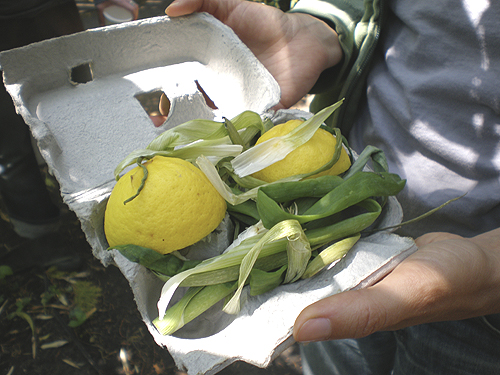
Over the past few weeks my focus has shifted to developing new projects for wowhaus, my public art and design collaboration with my wife, Ene Osteraas-Constable. Many of our projects have their origins as ‘social sculpture’, where we create structures and situations designed to bring people together in convivial exchange.
Yesterday we introduced MIX, our human-powered, urban compost tumbler at Southern Exposure, a community-based gallery in San Francisco, temporarily sited in a residential block in the Mission District. We’ve been working in collaboration with a group of artists to develop a curatorial component for the gallery’s tiny garden, and proposed to kick things off with a community ‘pot luck’ around the topics of compost, soil and urban gardening. We set up tables and chairs in the gallery, decorated with hand-embroidered tablecloths, and invited neighbors to bring a home-cooked dish to share as well as their kitchen scraps to feed the composter. Most people arrived with a salad or fruit, and we spent a lively afternoon hanging out, swapping stories, feeding the composter and discussing the garden’s potential.
Kristin Palm, a San Francisco-based writer who recently wrote a feature on Deep Craft for Metropolis magazine’s POV project, showed up with clippings of her own hair for the composter. Human hair is loaded with nitrogen, a key ingredient in making fertile soil.

With the help of my friend and neighbor Steve Shoulders, I designed and built the composter with ready-made materials culled from the waste stream, including a Spanish-made exer-cycle, an olive barrel, and a bicycle wheel donated by The Recyclery Bike Shop of Oakland. Pumping the handlebars pulls a ratcheted cable, which spins the wheel with barrel attached, mixing and aerating the contents for rapid and even decomposition.
Much of the discussion centered on how to optimize the pedal power potential. Our original plan was to spin a 12 V generator to charge a battery to power a laptop or equivalent, but we decided to allow the site and situation to determine the best use. This method of composting produces a liquid ‘tea’ that, when drained, is very nutritious for growing plants. A few of the garden-savvy participants suggested collecting the ‘tea’ drained from the decomposing matter, and using the pedal power to pump it to a mister which could be moved around the garden. Regardless of the thing powered, simply providing exercise for the gallery staff during a stessful restructuring and growth cycle is a worthy outcome of ‘pedal power’ for now.

For the event, I made cole slaw from cabbage and carrots grown nearby. I sliced 3 heads of cabbage, chopped up 2 bunches of carrots, and mixed in a sauce made from 1/2 cup Vietnamese garlic/chili sauce (sambal oelek), 1/2 cup rice vinegar, 3 tablespoons sugar and 1 cup of olive oil, slowly whipped in.
The MIX composter will be installed in Southern Exposure’s garden for the entire summer, and the gallery’s community will determine how best to utilize the soil generated from neighborhood kitchen scraps. MIX is the latest in a series of wowhaus’ community-based interventions; others include Friesel, Tree Trust True, Life on Market Street, and the Ecology/Expedition Survey. Wowhaus public projects model community production strategies, a hallmark of Deep Craft.


Could you please provide plans so that anybody seeing this can build it themselves?
I would love to, but this is very much a one-off project, meant to inspire similar DIY experimentation.